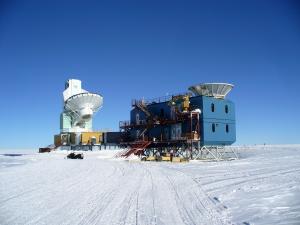Blog
Dirty Laundry
14 May 2014
 Wikipedia user Amble
Wikipedia user AmbleRecently rumors have been flying that the BICEP2 results regarding the cosmic inflationary period may be invalid. It makes for great headline press, but the reality is not quite so sensational. There may be some issues with the BICEP2 results, but that isn’t what the press is excited about. What they are really excited about is how science groups are airing their dirty laundry, publicly. So what’s really going on?
For those who might not remember, BICEP2 is a project working to detect polarized light within the cosmic microwave background (CMB). Specifically they were looking for a type of polarization known as B-mode polarization. Detection of B-mode polarization is important because one mechanism for it is cosmic inflation in the early universe, which is exactly what BICEP2 claimed to have evidence of.
Part of the reason BICEP2 got so much press is because B-mode polarization is particularly difficult to detect. It is a small signal, and you have to filter through a great deal of observational data to be sure that your result is valid. But you also have to worry about other sources that look like B-mode polarization, and if you don’t account for them properly, then you could get a “false positive.” That’s where this latest drama arises.
In general this challenge is sometimes called the foreground problem. Basically, the cosmic microwave background is the most distant light we can observe. All the galaxies, dust, interstellar plasma and our own galaxy is between us and the CMB. So to make sure that the data you gather is really from the CMB, you have to account for all the stuff in the way (the foreground). We have ways of doing this, but it is difficult. The big challenge is to account for everything.
You might remember a while back I wrote about one foreground effect that BICEP2 didn’t take into account. It involves an effect known as radio loops, where dust particles trapped in interstellar magnetic fields can emit polarized light similar to B-mode polarization. How much of an effect this might have is unclear. Another project being done with the Planck satellite is also looking at this foreground effect, and has released some initial results, but hasn’t yet released the actual data yet.
Now it has come to light that BICEP2 did, in fact, take some of this foreground polarization into account, using results from Planck. But since the raw data hadn’t been released, the team used data taken from a PDF slide of Planck results and basically reverse-engineered the Planck data. This isn’t ideal, but it works moderately well. Now there is some debate as to whether that slide presented the real foreground polarization or some averaged polarization. If it is the latter, then the BICEP2 results may have underestimated the foreground effect. Does this mean the BICEP2 results are completely invalid? Given what I’ve seen so far, I don’t think it does. Keep in mind that the Planck foreground is one of several foreground effects that BICEP2 did account for. It could be a large error, but it could also be a rather minor one.
Because of all this drama, there are already posts out there claiming that this is evidence of scientists behaving badly, or declaring this kind of thing shows that scientists don’t really know anything. But it is important to keep in mind that the BICEP2 paper is still undergoing peer review. Critical analysis of the paper is exactly what should happen, and is happening. This type of dirty laundry used to be confined to the ivory towers, but with social media it now happens in the open. This is how science is done. BICEP2 has made a bold claim, and now everyone gets to whack at them like a piñata.
Now lets see if their result holds up, or falls apart.